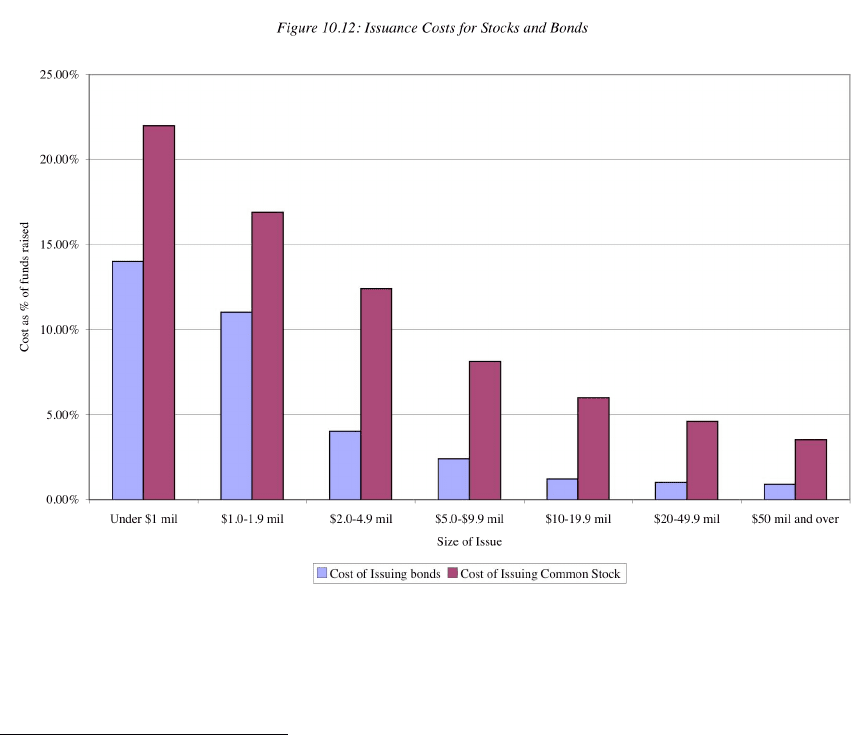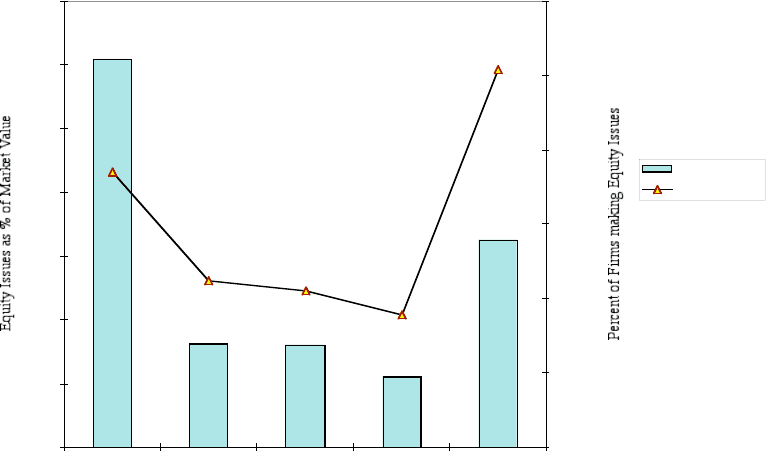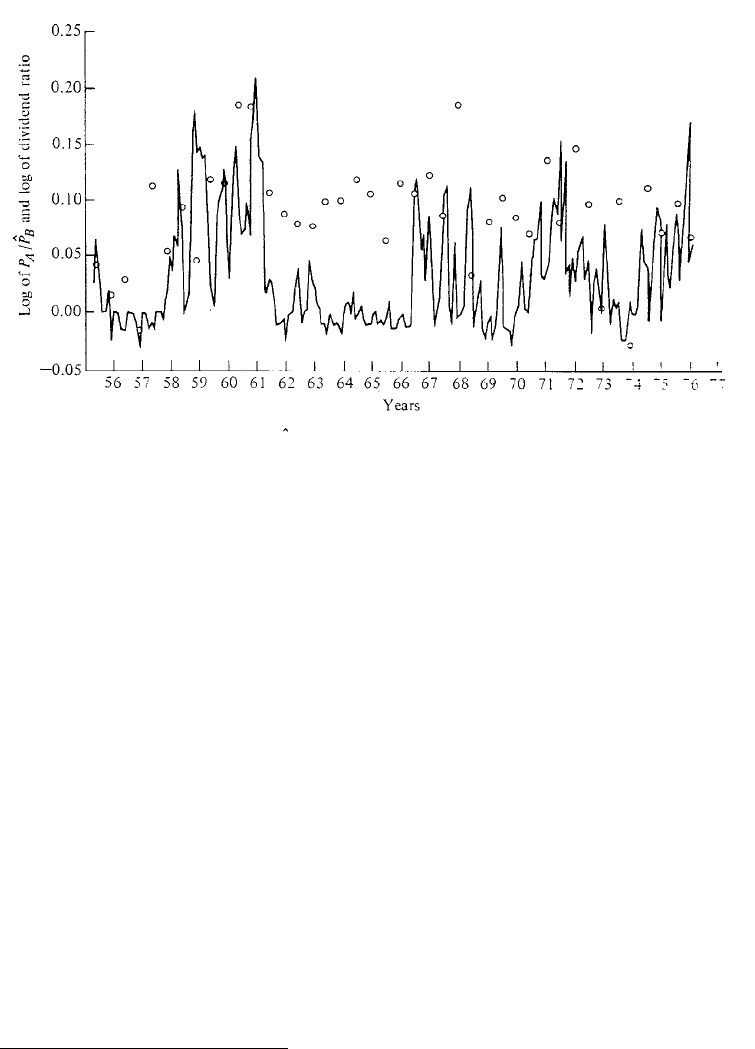Damodaran A. Applied corporate finance
Подождите немного. Документ загружается.


29
29
b. capital gains have a tax advantage relative to dividends
c. dividends and capital gains are taxed at the same rate
Explain.
The “Dividends Are Good” School
Notwithstanding the tax disadvantages, firms continue to pay dividends and they
typically view such payments positively. A third school of thought that argues dividends
are good and can increase firm value. Some of the arguments used by this school are
questionable, but some have a reasonable basis in fact. We consider both in this section.
Some Reasons for Paying Dividends that do not measure up
Some firms pay and increase dividends for the wrong reasons. We will consider
two of those reasons in this section.
The Bird-in-the-Hand Fallacy
One reason given for the view that investors prefer dividends to capital gains is
that dividends are certain, whereas capital gains are uncertain. Proponents of this view of
dividend policy feel that risk averse investors will therefore prefer the former. This
argument is flawed. The simplest counter-response is to point out that the choice is not
between certain dividends today and uncertain capital gains at some unspecified point in
the future, but between dividends today and an almost equivalent amount in price
appreciation today. This comparison follows from our earlier discussion, where we noted
that the stock price dropped by slightly less than the dividend on the ex-dividend day. By
paying the dividend, the firm causes its stock price to drop today.
Another response to this argument is that a firm’s value is determined by the cash
flows from its projects. If a firm increases its dividends but its investment policy remains
unchanged, it will have to replace the dividends with new stock issues. The investor who
receives the higher dividend will therefore find himself or herself losing, in present value
terms, an equivalent amount in price appreciation.

30
30
Temporary Excess Cash
In some cases, firms are tempted to pay or initiate dividends in years in which
their operations generate excess cash. Although it is perfectly legitimate to return excess
cash to stockholders, firms should also consider their own long-term investment needs. If
the excess cash is a temporary phenomenon, resulting from having an unusually good
year or a non-recurring action (such as the sale of an asset), and the firm expects cash
shortfalls in future years, it may be better off retaining the cash to cover some or all these
shortfalls. Another option is to pay the excess cash as a dividend in the current year and
issue new stock when the cash shortfall occurs. This is not very practical because the
substantial expense associated with new security issues makes this a costly strategy in the
long term. Figure 10.12 summarizes the cost of issuing bonds and common stock, by size
of issue in the United States.
9
Source: Ibbotson, Sindelar and Ritter (1997)
9
Ibbotson, R. G., J. L. Sindelar and J. R. Ritter. 1988, Initial Public Offerings, Journal of Applied
Corporate Finance, v1(2), 37-45.

31
31
Since issuance costs increase as the size of the issue decreases and for common
stock issues, small firms should be especially cautious about paying out temporary excess
cash as dividends. This said, it is important to note that some companies do pay dividends
and issue stock during the course of the same period, mostly out of a desire to maintain
their dividends. Figure 10.13 reports new stock issues by firms as a percentage of firm
value, classified by their dividend yields, in 1998.
Figure 21.11: Equity Issues by Dividend Class, United States - 1998
0.0%
1.0%
2.0%
3.0%
4.0%
5.0%
6.0%
7.0%
No dividends < 1% 1 - 2% 2- 4.5% > 4.5%
Dividend Yield Class
Equity Issues as % of Market Value
0.00%
10.00%
20.00%
30.00%
40.00%
50.00%
60.00%
Percent of Firms making Equity Issues
New Issue Yld
New Issues
Source: Compustat database, 1998
While it is not surprising that stocks that pay no dividends are most likely to issue stock,
it is surprising that firms in the highest dividend yield class also issue significant
proportions of new stock (approximately half of all the firms in this class also make new
stock issues). This suggests that many of these firms are paying dividends on the one
hand and issuing stock on the other, creating significant issuance costs for their
stockholders in the process.
Some Good Reasons for Paying Dividends
While the tax disadvantages of dividends are clear, especially for individual
investors, there are some good reasons why firms that are paying dividends should not

32
32
suspend them. First, there are investors who like to receive dividends, either because they
pay no or very low taxes, or because they need the regular cash flows. Firms that have
paid dividends over long periods are likely to have accumulated investors with these
characteristics, and cutting or eliminating dividends would not be viewed favorably by
this group.
Second, changes in dividends allow firms to signal to financial markets how
confident they feel about future cash flows. Firms that are more confident about their
future are therefore more likely to raise dividends; stock prices often increase in response.
Cutting dividends is viewed by markets as a negative signal about future cashflows, and
stock prices often decline in response. Third, firms can use dividends as a tool for altering
their financing mix and moving closer to an optimal debt ratio. Finally, the commitment
to pay dividends can help reduce the conflicts between stockholders and managers, by
reducing the cash flows available to managers.
Some investors like dividends
Many in the “dividends are bad” school of thought argue that rational investors
should reject dividends due to their tax disadvantage. Whatever you might think of the
merits of that argument, some investors have a strong preference for dividends and view
large dividends positively. The most striking empirical evidence for this comes from
studies of companies that have two classes of shares: one that pays cash dividends, and
another that pays an equivalent amount of stock dividends; thus, investors are given a
choice between dividends and capital gains.
John Long studied the price differential on Class A and B shares traded on
Citizens Utility.
10
Class B shares paid a cash dividend, while Class A shares paid an
equivalent stock dividend. Moreover, Class A shares could be converted at little or no
cost to Class A shares at the option of its stockholders. Thus, an investor could choose to
buy Class B shares to get cash dividends, or Class A shares to get an equivalent capital
gain. During the period of this study, the tax advantage was clearly on the side of capital
gains; thus, we would expect to find Class B shares selling at a discount on Class A
10
Long, John B., Jr., 1978, The Market Valuation Of Cash Dividends: A Case To Consider, Journal of
Financial Economics, 1978, v6(2/3), 235-264.

33
33
shares. The study found, surprisingly, that the Class B shares sold at a premium over
Class A shares. Figure 10.14 reports the price differential between the two share classes
over the period of the analysis.
Figure 10.14: Price Differential on Citizen’s Utility Stock
Source: Long (1978)
While it may be tempting to attribute this phenomenon to the irrational behavior of
investors, such is not the case. Not all investors like dividends –– many feel its tax
burden–– but there are also many who view dividends positively. These investors may
not be paying much in taxes and consequently do not care about the tax disadvantage
associated with dividends. Or they might need and value the cash flow generated by the
dividend payment. Why, you might ask, do they not sell stock to raise the cash flow they
need? The transactions costs and the difficulty of breaking up small holdings
11
and
selling unit shares may make selling small amounts of stock infeasible.
11
Consider a stockholder who owns 100 shares trading at $ 20 per share, on which she receives a dividend
of $0.50 per share. If the firm did not pay a dividend, the stockholder would have to sell 2.5 shares of stock
to raise the $ 5 that would have come from the dividend.

34
34
Bailey extended Long’s study to examine Canadian utility companies, which also
offered dividend and capital-gains shares, and had similar findings.
12
Table 10.2
summarizes the price premium at which the dividend shares sold.
Table 10.2: Price Differential between Cash and Stock Dividend Shares
Company
Premium on Cash Dividend Shares over
Stock Dividend Shares
Consolidated Bathurst
19.30%
Donfasco
13.30%
Dome Petroleum
0.30%
Imperial Oil
12.10%
Newfoundland Light & Power
1.80%
Royal Trustco
17.30%
Stelco
2.70%
TransAlta
1.10%
Average
7.54%
Source: Bailey (1988)
Note, once again, that on average the cash dividend shares sell at a premium of 7.5% over
the stock dividend shares. We caution that while these findings do not indicate that all
stockholders like dividends, they do indicate that the stockholders in these specific
companies liked cash dividends so much that they were willing to overlook the tax
disadvantage and pay a premium for shares that offered them.
The Clientele Effect
Stockholders examined in the studies described above clearly like cash dividends.
At the other extreme are companies that pay no dividends, such as Microsoft, and whose
stockholders seem perfectly content with that policy. Given the vast diversity of
stockholders, it is not surprising that, over time, stockholders tend to invest in firms
whose dividend policies match their preferences. Stockholders in high tax brackets who
do not need the cash flow from dividend payments tend to invest in companies that pay
low or no dividends. By contrast, stockholders in low tax brackets who need the cash
from dividend payments, and tax-exempt institutions that need current cash flows, will
usually invest in companies with high dividends. This clustering of stockholders in
12
Bailey, W., 1988, Canada's Dual Class Shares: Further Evidence On The Market Value Of Cash
Dividends, Journal of Finance, 1988, v43(5), 1143-1160

35
35
companies with dividend policies that match their preferences is called the clientele
effect.
The existence of a clientele effect is supported by empirical evidence. One study
looked at the portfolios of 914 investors to see whether their portfolios were affected by
their tax brackets. The study found that older and poorer investors were more likely to
hold high-dividend-paying stocks than were younger and wealthier investors.
In another study, dividend yields were regressed against the characteristics of the
investor base of a company (including age, income and differential tax rates).
13
Dividend Yield
t
= a + b β
t
+ c Age
t
+ d Income
t
+ e Differential Tax Rate
t
+ ε
t
Variable
Coefficient
Implies
Constant
4.22%
Beta Coefficient
-2.145
Higher beta stocks pay lower dividends.
Age/100
3.131
Firms with older investors pay higher
dividends.
Income/1000
-3.726
Firms with wealthier investors pay lower
dividends.
Differential Tax Rate
-2.849
If ordinary income is taxed at a higher rate
than capital gains, the firm pays less
dividends.
Source: Pettit (1977)
Not surprisingly, this study found that safer companies, with older and poorer investors,
tended to pay more in dividends than companies with wealthier and younger investors.
Overall, dividend yields decreased as the tax disadvantage of dividends increased.
10.7. ☞: Dividend Clientele and Tax Exempt Investors
Pension funds are exempt from paying taxes on either ordinary income or capital gains,
and also have substantial ongoing cash flow needs. What types of stocks would you
expect these funds to buy?
a. Stocks that pay high dividends
b. Stocks that pay no or low dividends
Explain.
13
Pettit, R. R., 1977, Taxes, Transactions Costs and the Clientele Effect of Dividends, Journal of Financial
Economics, v5, 419-436.
36
36
Consequences of the Clientele Effect
The existence of a clientele effect has some important implications. First, it
suggests that firms get the investors they deserve, since the dividend policy of a firm
attracts investors who like it. Second, it means that firms will have a difficult time
changing an established dividend policy, even if it makes complete sense to do so. For
instance, U.S. telephone companies have traditionally paid high dividends and acquired
an investor base that liked these dividends. In the 1990s, many of these firms entered new
businesses (entertainment, multi-media etc.), with much larger reinvestment needs and
less stable cash flows. While the need to cut dividends in the face of the changing
business mix might seem obvious, it was nevertheless a hard sell to stockholders, who
had become used to the dividends.
The clientele effect also provides an alternative argument for the irrelevance of
dividend policy, at least when it comes to valuation. In summary, if investors migrate to
firms that pay the dividends that most closely match their needs, no firm’s value should
be affected by its dividend policy. Thus, a firm that pays no or low dividends should not
be penalized for doing so, because its investors do not want dividends. Conversely, a firm
that pays high dividends should not have a lower value, since its investors like dividends.
This argument assumes that there are enough investors in each dividend clientele to allow
firms to be fairly valued, no matter what their dividend policy.
Empirical Evidence on the Clientele Effect
Researchers have investigated whether the clientele effect is strong enough to
separate the value of stocks from dividend policy. If there is a strong enough clientele
effect, the returns on stocks should not be affected, over long periods, by the dividend
payouts of the underlying firms. If there is a tax disadvantage associated with dividends,
the returns on stocks that pay high dividends should be higher than the returns on stocks
that pay low dividends, to compensate for the tax differences. Finally, if there is an
overwhelming preference for dividends, these patterns should be reversed.
In their study of the clientele effect, Black and Scholes (1974) created 25
portfolios of NYSE stocks, classifying firms into five quintiles based upon dividend
yield, and then subdivided each group into five additional groups based upon risk (beta)

37
37
each year for 35 years, from 1931 to 1966.
14
When they regressed total returns on these
portfolios against the dividend yields, the authors found no statistically significant
relationship between the two. These findings were contested in a later study by
Litzenberger and Ramaswamy (1979), who used updated dividend yields every month
and examined whether the total returns in ex-dividend months were correlated with
dividend yields.
15
They found a strong positive relationship between total returns and
dividend yields, supporting the hypothesis that investors are averse to dividends. They
also estimated that the implied tax differential between capital gains and dividends was
approximately 23%. Miller and Scholes (1981) countered by arguing that this finding was
contaminated by the stock price effects of dividend increases and decreases.
16
In
response, they removed from the sample all cases in which the dividends were declared
and paid in the same month and concluded that the implied tax differential was only 4%,
which was not significantly different from zero.
In the interests of fairness, we should point out that most studies of the clientele
effect have concluded that total returns and dividend yields are positively correlated.
Although many of them contend that this is true because the implied tax differential
between dividends and capital gains is significantly different from zero, there are
alternative explanations for the phenomena. In particular, while one may disagree with
Miller and Scholes’ conclusions, their argument - that the higher returns on stocks that
pay high dividends might have nothing to do with the tax disadvantages associated with
dividends but may instead be a reflection of the price increases associated with
unexpected dividend increases - has both a theoretical and an empirical basis, as
discussed below.
10.8. ☞: Dividend Clientele and Changing Dividend Policy
Phone companies in the United States have for long had the following features - they are
regulated, have stable earnings, low reinvestment needs and pay high dividends. Many of
14
Black, F. and M. Scholes, 1974, The Effects of Dividend Yield and Dividend Policy on Common Stock
Prices and Returns, Journal of Financial Economics, v1, 1-22.
15
Litzenberger, R.H. and K. Ramaswamy, 1979, The Effect of Personal Taxes and Dividends on Capital
Asset Prices: Theory and Empirical Evidence, Journal of Financial Economics, Vol 7, 163-196.

38
38
these phone companies are now considering entering the multimedia age and becoming
entertainment companies, which requires more reinvestment and creates more volatility
in earnings. If you were the CEO of the phone company, would you
a. announce an immediate cut in dividends as part of a major capital investment plan
b. continue to pay high dividends, and use new stock issues to finance the expansion
c. something else:
Explain.
Dividends operate as a information signal
Financial markets examine every action a firm takes for implications for future
cash flows and firm value. When firms announce changes in dividend policy, they are
conveying information to markets, whether they intend to or not.
Financial markets tend to view announcements made by firms about their future
prospects with a great deal of skepticism, since firms routinely make exaggerated claims.
At the same time, some firms with good projects are under valued by markets. How do
such firms convey information credibly to markets? Signaling theory suggests that these
firms need to take actions that cannot be easily imitated by firms without good projects.
Increasing dividends is viewed as one such action. By increasing dividends, firms create
a cost to themselves, since they commit to paying these dividends in the long term. Their
willingness to make this commitment indicates to investors that they believe they have
the capacity to generate these cash flows in the long term. This positive signal should
therefore lead investors to reevaluate the cash flows and firm values and increase the
stock price.
Decreasing dividends is a negative signal, largely because firms are reluctant to
cut dividends. Thus, when a firm take this action, markets see it as an indication that this
firm is in substantial and long-term financial trouble. Consequently, such actions lead to a
drop in stock prices.
16
Miller, M. H. and M. S. Scholes, 1978, Dividends And Taxes, Journal of Financial Economics, v6(4),
333-364.
